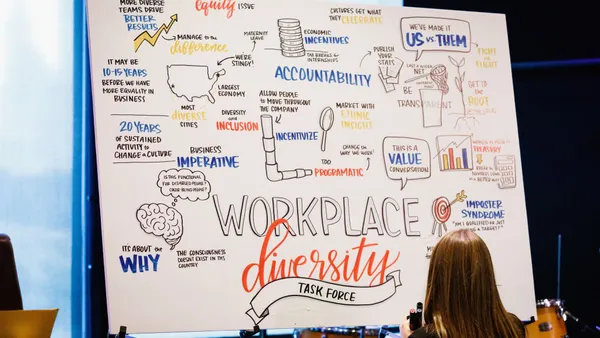As senior leadership teams evaluate their diversity, equity, inclusion and belonging (DEIB) strategies and objectives for 2023, they might consider the Second Law of Thermodynamics. This fundamental physics principle states that the entropy of an isolated system increases over time. This concept also applies to DEIB programs that fail to become institutionalized despite being launched with great fanfare.
Fortunately, there is a practical way to avoid this outcome and ensure that DEIB becomes fully embedded in organizational culture, leadership and business processes.
DEIB operating models are being designed and implemented on a weekly basis. While these frameworks necessarily vary by company, the most effective approaches share a common set of “integrated enablers” – components that help ensure that organizational efforts to drive inclusion become embedded in the fabric of daily operations, decisions and communications.
In our work helping companies develop roadmaps for institutionalizing DEIB, we’ve learned how organizations can drive DEIB throughout the company and among external stakeholder groups. The best approaches tend to begin by identifying a handful of key focus areas, such as the workplace, the workforce and the external marketplace.
Each focus area contains sub-components that DEIB policies and practices should address. Common marketplace components addressed in DEIB operating models include community engagement, brand exposure, reputation and third-party relationships. Workplace components often include organizational culture, employee engagement and education. Workforce components might consist of recruitment, retention and advancement.
From a design and execution perspective, an operating model must have enablers in place if it is to succeed in embedding DEIB into the culture. These components include:
- Leadership: Senior leaders should model DEIB behaviors in all of their interactions and communications. This requires a thorough awareness of, and sensitivity to, DEIB matters, along with a commitment to “walking the talk.” Leaders should continually reinforce DEIB principles and practices – not only when the program or an initiative is being rolled out, but on an ongoing basis. Senior leaders also should note that the head of DEIB’s position in the organizational structure and hierarchy speaks volumes about its importance. That’s not to say that a C-suite title or a direct reporting relationship to the CEO is required. However, many employees and external stakeholders will perceive a DEIB program differently depending on whether it is helmed by a specialist or manager as opposed to a director-and-above level employee.
- Communications: DEIB-related topics and performance should be woven into regular communication cadences from leaders and human resources functions. When organizations create new employee network (or resource) groups, for example, that news should be shared with employees and mentioned by leaders through existing communications channels. From an external reporting perspective, the vast majority of publicly listed companies share DEIB data and metrics with shareholders and other stakeholders in the human capital disclosures that the U.S. Securities and Exchange Commission (SEC) now requires. Investor relations (IR) teams and senior leaders should monitor shareholder responses to these disclosures as well as additional SEC guidance and leading human capital reporting practices as they unfold.
- Policies and Practices: Policies and practices document how DEIB programs will operate in the organization. As such, these policies should address how DEIB considerations are integrated into numerous capabilities and processes, including the employee experience, performance management, recruiting, retention, advancement, compensation and more.
- Metrics and Data: The DEIB metrics that an organization measures and manages should align with their program’s strategic objectives. Some companies may emphasize key performance indicators (KPIs) related to gender diversity in leadership roles, while others prioritize KPIs related to racial diversity throughout the workforce. Ideally, organizations should identify three to five DEIB KPIs that help them monitor and continually improve the program’s performance. Tracking one or two metrics may not provide a sufficiently comprehensive assessment of performance; tracking too many KPIs raises questions about the program’s priorities.
- Financial Investment: The good news is that DEIB programs generally do not require oversized budgets. It’s more important to ensure that the DEIB resources and activities being funded operate in a coordinated manner, thereby generating the most bang for the buck. Hard dollars are probably less important than leaders who support the program and model the right behaviors on a daily basis. That said, human capital investments must be sufficient. A global company with 50,000 employees likely needs more than two specialist-level employees running the DEIB program.
It's also good news that embedding DEIB into organizational culture and processes does not require a degree in advanced physics. All that’s needed to operationalize DEIB is the right commitment, planning and structure.










